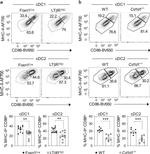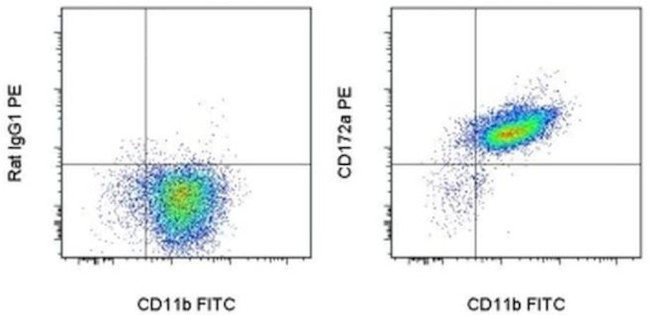Search Thermo Fisher Scientific
Invitrogen
CD172a (SIRP alpha) Monoclonal Antibody (P84), PE, eBioscience™
图: 1 / 2
CD172a (SIRP alpha) Antibody (12-1721-82) in Flow


产品信息
12-1721-82
种属反应
已发表种属
宿主/亚型
分类
类型
克隆号
偶联物
激发/发射光谱
形式
浓度
纯化类型
保存液
内含物
保存条件
运输条件
RRID
产品详细信息
Description: This P84 monoclonal antibody reacts with mouse CD172a, also known as signal regulatory protein a (SIRPa). This cell surface glycoprotein consists of three Ig-like extracellular domains and two cytoplasmic immunoreceptor tyrosine-based inhibitory motifs (ITIMs). The ITIM domains have been demonstrated to recruit and bind the Src homology 2 domain-containing phosphatases SHP-1 and SHP-2. CD172a is expressed on monocytes, macrophages, dendritic cells, but not on T and B lymphocytes. Moreover, neurons and other tissues of the central nervous system have also been shown to express CD172a. The integrin-associated protein CD47 is the extracellular ligand for CD172a. Studies show that CD172a is involved in dendritic cell-mediated T cell activation, neutrophil migration, and phagocytosis.
This monoclonal antibody has been reported to have neutralizing activity.
Applications Reported: This P84 antibody has been reported for use in flow cytometric analysis.
Applications Tested: This P84 antibody has been tested by flow cytometric analysis of mouse bone marrow cells. This can be used at less than or equal to 0.5 µg per test. A test is defined as the amount (µg) of antibody that will stain a cell sample in a final volume of 100 µL. Cell number should be determined empirically but can range from 10^5 to 10^8 cells/test. It is recommended that the antibody be carefully titrated for optimal performance in the assay of interest.
Excitation: 488-561 nm; Emission: 578 nm; Laser: Blue Laser, Green Laser, Yellow-Green Laser.
Filtration: 0.2 µm post-manufacturing filtered.
靶标信息
SIRP alpha (CD172a, signal-regulatory protein alpha) is a receptor-type transmembrane glycoprotein expressed on cells of myeloid origin, including granulocytes, dendritic cells (DCs), macrophages, mast cells and hematopoietic stem cells. SIRP alpha acts as a substrate for several activated tyrosine kinases, including EGFR, PDGFR, src and insulin receptor and is involved in the negative regulation of receptor tyrosine kinase-coupled signaling pathways. The ligand binding of SIRP alpha to integrin-associated protein CD47 results in tyrosine kinase phosphorylation of immunoreceptor tyrosine-based inhibitory motifs (ITIMs) within the cytoplasmic region of SIRP alpha, which mediates the recruitment and activation of the tyrosine phosphatases SHP-1 and SHP-2. Ligation of SIRP alpha with CD47 has been demonstrated in several regulatory processes, including the inhibition of host cell phagocytosis by macrophages and the bi-directional activation of T cells and DCs. SIRP alpha has regulatory effects on cellular responses induced by serum, growth factors, insulin, oncogenes, growth hormones and cell adhesion, and plays a general role in different physiological and pathological processes. Cancer cells highly express CD47, which activates SIRP alpha and inhibits macrophage-mediated destruction of cancerous cell growth.
仅用于科研。不用于诊断过程。未经明确授权不得转售。
How to use the Panel Builder
Watch the video to learn how to use the Invitrogen Flow Cytometry Panel Builder to build your next flow cytometry panel in 5 easy steps.
生物信息学
蛋白别名: Bit; Brain Ig-like molecule with tyrosine-based activation motifs; brain immunological-like with tyrosine-based motifs; CD172 alpha; CD172 antigen-like family member A; CD172a; Inhibitory receptor SHPS-1; mSIRP-alpha1; MyD-1 antigen; p84; protein tyrosine phosphatase, non-receptor type substrate 1; SHP substrate 1; Signal-regulatory protein alpha-1; Sirp-alpha-1; SIRPalpha; SIRPalpha2; Tyrosine-protein phosphatase non-receptor type substrate 1
基因别名: AI835480; Bit; CD172a; Myd1; P84; Ptpns1; SHP-1; SHPS-1; Shps1; SIRP; Sirpa
UniProt ID: (Mouse) P97797
Entrez Gene ID: (Mouse) 19261




